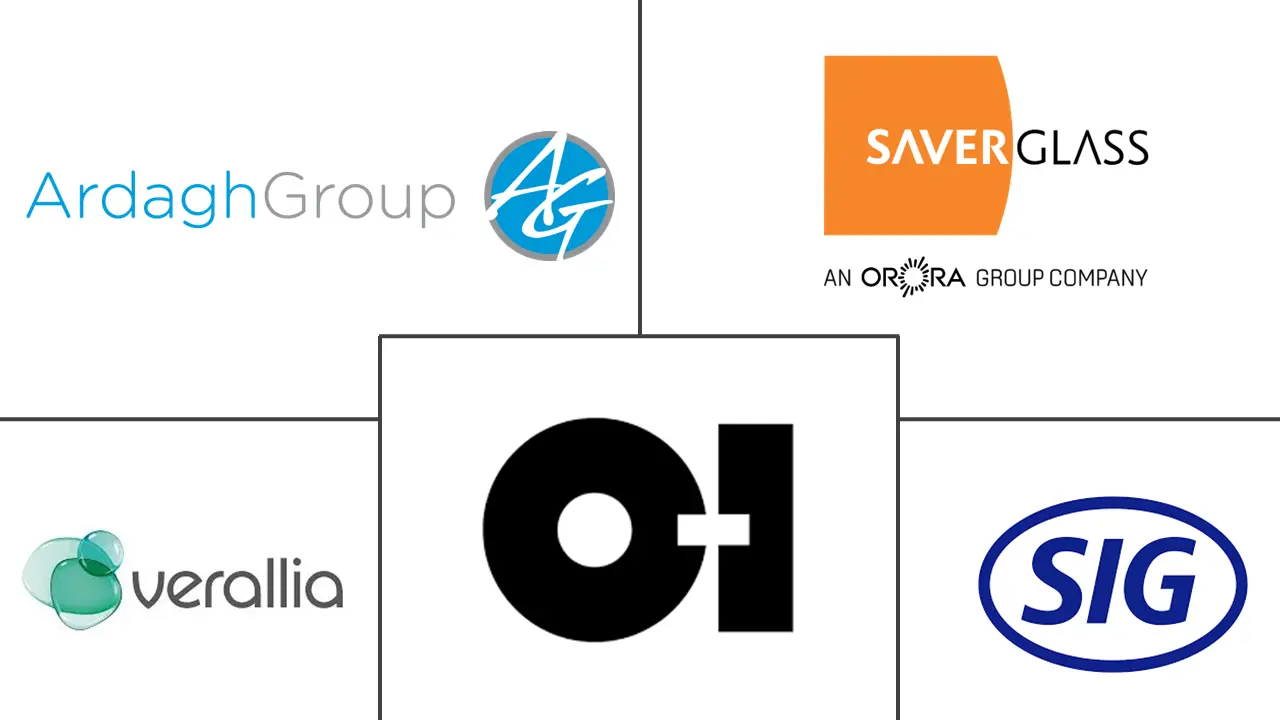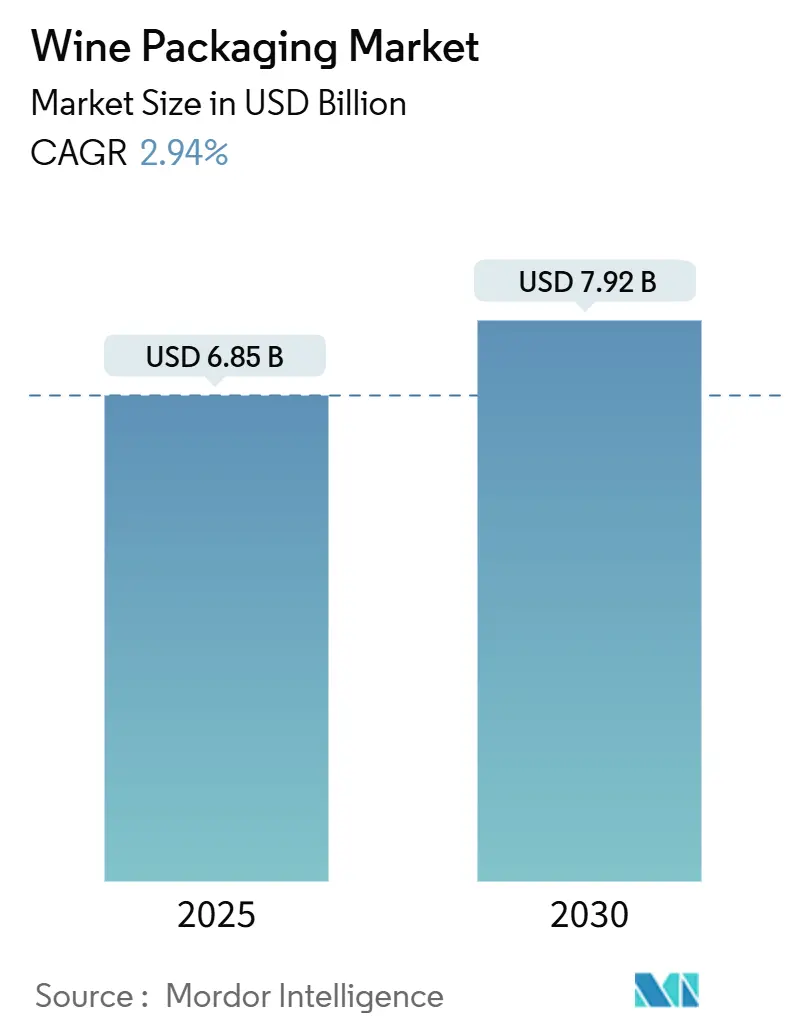
Wine Packaging Market Analysis by Mordor Intelligence
The wine packaging market size reached USD 6.85 billion in 2025 and is forecast to climb to USD 7.92 billion by 2030, advancing at a 2.94% CAGR over the period. Strong glass bottle demand, growing interest in lightweight designs, and the rapid adoption of alternative formats such as cans and bag-in-box options are steering this trajectory. Premiumisation in China, lightweight glass roll-outs in Europe, and direct-to-consumer (DtC) acceleration in North America are reshaping production scale and logistics economics across the wine packaging market. Regulatory pressure-from the European Union’s 100%-recyclable-by-2030 mandate to California’s redemption-value expansion-continues to push suppliers toward circular materials and energy-efficient furnaces, even as glass price volatility persists. Metal packaging’s recyclability appeals to younger, mobile consumers, while bio-based closures gain traction as vineyards certify sustainability practices.
Key Report Takeaways
- By material, glass retained 68.71% of the wine packaging market share in 2024; metal is projected to expand at a 5.46% CAGR to 2030.
- By product type, glass bottles led with 68.71% of the revenue in 2024, while the bag-in-box segment is forecasted to grow at a 6.14% CAGR through 2030.
- By closure type, the screw caps segment captured 55.30% share of the wine packaging market size in 2024, and is projected to grow at a CAGR of 5.36% through 2030.
- By wine type, still wines held 71.37% of category volume in 2024; low- and no-alcohol wines are set to record a 4.63% CAGR to 2030.
- By capacity, the 375-750 mL segment controlled 72.82% of the wine packaging market share in 2024, while the more than 1,500 mL segment is projected to grow at a CAGR of 3.48% through 2030.
- By distribution channel, the direct sales segment accounted for 70.28% of 2024 revenue and is projected to rise at a 3.26% CAGR to 2030.
- By geography, Europe led with 49.75% revenue in 2024, while Asia-Pacific is forecasted to grow at a 4.67% CAGR through 2030.
Global Wine Packaging Market Trends and Insights
Drivers Impact Analysis
| Driver | (~) % Impact on CAGR Forecast | Geographic Relevance | Impact Timeline |
|---|---|---|---|
| Premiumisation of wine in China elevating demand for designer bottles | +0.8% | China, wider APAC | Medium term (2-4 years) |
| Lightweight glass bottle adoption by European wineries to cut CO₂ | +0.6% | Europe, North America | Long term (≥ 4 years) |
| Rapid uptake of bag-in-box formats in Nordic e-grocery | +0.4% | Nordics, N. Europe | Short term (≤ 2 years) |
| Rise of DtC channels in the US accelerating ready-to-ship packs | +0.5% | North America | Medium term (2-4 years) |
| Surge in canned and PET single-serve wines for outdoor use in Oceania | +0.3% | Australia, New Zealand | Short term (≤ 2 years) |
| Vineyard sustainability certifications driving bio-based closures | +0.2% | Global premium regions | Long term (≥ 4 years) |
| Source: Mordor Intelligence | |||
Premiumisation of Wine in China Elevating Demand for Designer Bottles
Young urban consumers in China value convenience and affordability yet still associate sophisticated design with quality. Innovations such as Huadong Winery’s keg wine and Franzia’s boxed offerings support casual gatherings without diluting brand equity, lifting premium-styled alternatives within the wine packaging market. [1] Vino Joy, “How Unconventional Wine Packaging Is Winning Over Young Palates in China,” vino-joy.com
Lightweight Glass Bottle Adoption by European Wineries to Cut CO₂
Bourgogne’s carbon-neutral roadmap exposed bottle weight as a critical emissions driver; Verallia’s 300 g Bordeaux Air proves that a lighter bottle can retain tradition while trimming up to 40% of CO₂, propelling broader adoption across the wine packaging market. [2]Meininger's International, “Sweden Bids Farewell to Heavy Bottles,” meiningers-international.com
Rapid Uptake of Bag-in-Box Formats in the Nordics’ E-grocery Channel
Systembolaget’s policies helped bag-in-box capture more than 50% volume in Sweden and Norway, delivering 40% logistics savings and reinforcing environmental credentials that resonate in the wine packaging market.
Rise of DtC Channels in the US Accelerating On-premise Ready-to-Ship Packaging
California’s CRV expansion aligns packaging with recycling targets, rewarding solutions that ship safely and recycle easily, boosting sales through DtC platforms that underpin the wine packaging market.
Restraints Impact Analysis
| Restraint | (~) % Impact on CAGR Forecast | Geographic Relevance | Impact Timeline |
|---|---|---|---|
| EU plastic packaging taxes increasing PET cost | -0.4% | Europe, spillover | Short term (≤ 2 years) |
| Recyclate shortages limiting rPET roll-outs | -0.3% | Global, esp. EU & US | Medium term (2-4 years) |
| Higher oxygen transmission risk in alt-closures | -0.2% | Global premium tiers | Long term (≥ 4 years) |
| Soda-ash price volatility inflating glass costs | -0.5% | Global | Short term (≤ 2 years) |
| Source: Mordor Intelligence | |||
EU Plastic Packaging Taxes Increasing Cost of PET Solutions
Mandatory recycled-content quotas and PFAS bans inflate compliance costs, making PET less competitive for premium lines within the wine packaging market.
Global Recyclate Supply Shortages Limiting rPET Wine Bottle Roll-outs
Competition with soft drinks for food-grade rPET escalates prices; wine volumes lack the scale to secure feedstock, constraining sustainable goals across the wine packaging market.
Segment Analysis
By Material Type: Glass Dominance Faces Metal Innovation
Glass accounted for 68.71% of the wine packaging market in 2024 due to its inert nature and premium perception. Lightweight furnace upgrades and higher cullet ratios help maintain leadership while cutting emissions. Metal’s 5.46% CAGR reflects aluminum’s recyclability and chill-speed advantages, luring outdoor-oriented consumers and shaping future preference across the wine packaging market. [3]Metal Packaging Europe, “A Revolution for the Wine Industry?” metalpackagingeurope.org Paper bottles from Frugalpac and PET hybrids broaden the material field as regulators push 100% recyclable targets.
Plastic and paper advances test longstanding hierarchies. Frugalpac’s fibre shell uses 77% less plastic and holds an 84% lower carbon footprint than glass, making it an attractive alternative in the wine packaging industry. Glass manufacturers counter by piloting electric furnaces and ultra-light designs. Aluminum bottles leverage resealable tops to extend freshness, while bio-based PET integrates up to 30% rPET yet awaits a greater recyclate supply.
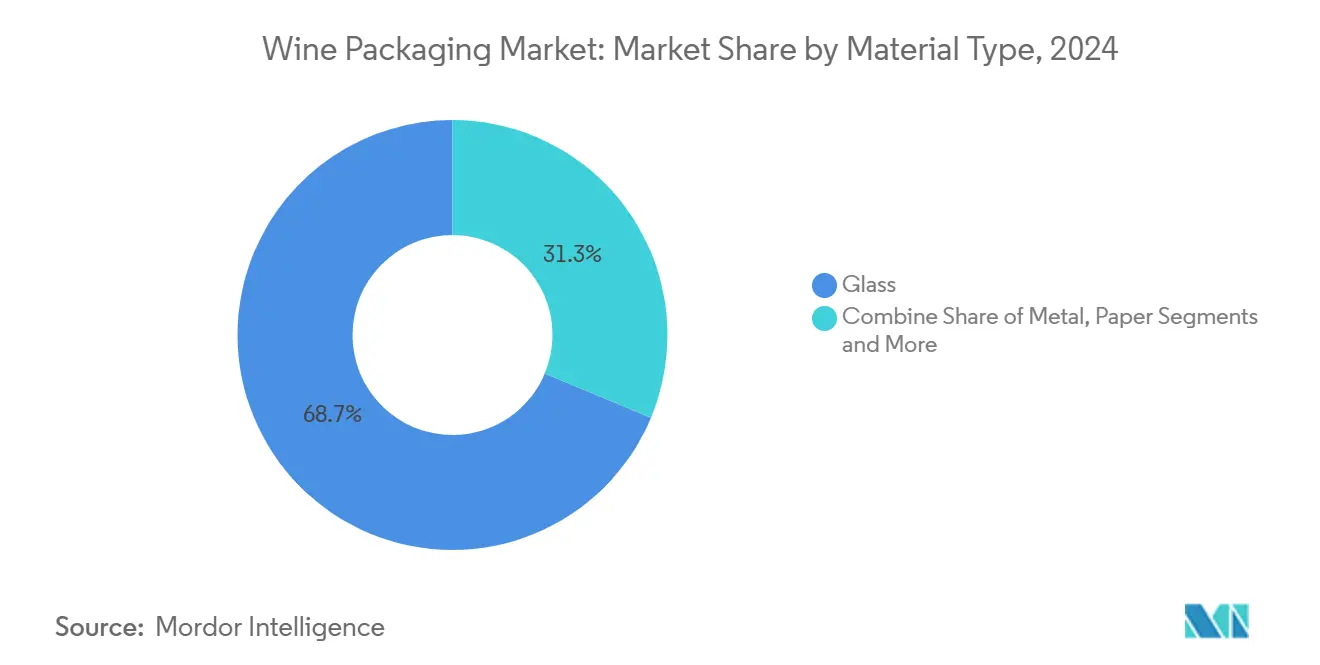
Note: Segment shares of all individual segments available upon report purchase
By Product Type: Bottles Lead While Cans Accelerate
Traditional glass and plastic bottles delivered 72.06% of 2024 revenue, an anchor for cellaring and ritual. Still, the bag-in-box segment is growing at a 6.14% CAGR, meeting convenience and regulations within the wine packaging market. Bag-in-box lines achieve scale benefits and hold 56% of Swedish volume, illustrating premium-grade evolution.
PET bottles secure niche roles with a six-month shelf life thanks to ALPLA’s barrier layers, while pouches win festival share. Smart labels that satisfy EU digital mandates surface on bottles and cans alike, enriching traceability and reinforcing the wine packaging market’s omnichannel strategy.
By Closure Type: Strategic Role of Screw Caps in the Market
Packaging formats utilizing screw caps dominate global wine packaging, accounting for 55.30% in 2024, due to their reliability, cost efficiency, and alignment with consumer preferences. Aluminum screw caps provide excellent oxygen management, consistent sealing, and reduced cork taint risk, appealing to winemakers and consumers. Their lightweight design, compatibility with high-speed bottling lines, and lower transportation costs make them more viable than corks. In regions like Australia, New Zealand, and North America, screw caps are the preferred closure for young and mid-tier wines. Their convenience, ease of opening, and re-sealability suit casual, single-serve, and on-the-go consumption.
Screw caps are also vital as brands focus on quality, sustainability, and growth. Advances in liner technology, such as Saranex and Tin-Saran, allow wineries to customize oxygen ingress for varietals and aging, making them suitable for premium wines. Sustainability goals drive adoption as aluminum screw caps are recyclable and have a lower carbon footprint than corks. The rise of canned wines, PET bottles, and other formats further supports screw caps in packaging innovations. As wine consumption trends shift toward convenience and consistency, especially among younger consumers, packaging formats utilizing screw caps are expected to grow at a CAGR of 5.36% through 2030.
By Wine Type: Still Wine Dominance Challenged by Low-Alcohol Innovation
Still wine carried 71.37% market share in 2024. Health trends push low- and no-alcohol lines to a 4.63% CAGR, demanding lighter, informative packaging in the wine packaging market. Sparkling lines maintain pressure-resistant bottles yet adopt capsule-free necks to save resources.
Fortified and dessert wines embrace smaller glasses to curb oxidation and align with moderation, while low-alcohol labels employ shrink-sleeve graphics to broadcast calorie counts. QR-code disclosures lift transparency and meet upcoming EU e-label rules, tightening convergence between wellness and the wine packaging industry.
By Capacity: Standard Bottles Dominate While Mini Formats Grow
The 375-750 mL tier delivered 72.82% of 2024 shipments and benefits from global line efficiencies. More than 1,500 mL volumes expand at a 3.48% CAGR, as large formats remain keynote for restaurant service and collector events, yet sustainability pushes them toward bulk-on-tap systems.
Mini bottles, often aluminum or PET, allow luxury producers to preserve price points while attracting trial. Standard bottles undergo 10-15% weight cuts via optimized glass allocation, maintaining strength but lowering freight emissions, reinforcing the wine packaging industry’s decarbonization agenda.
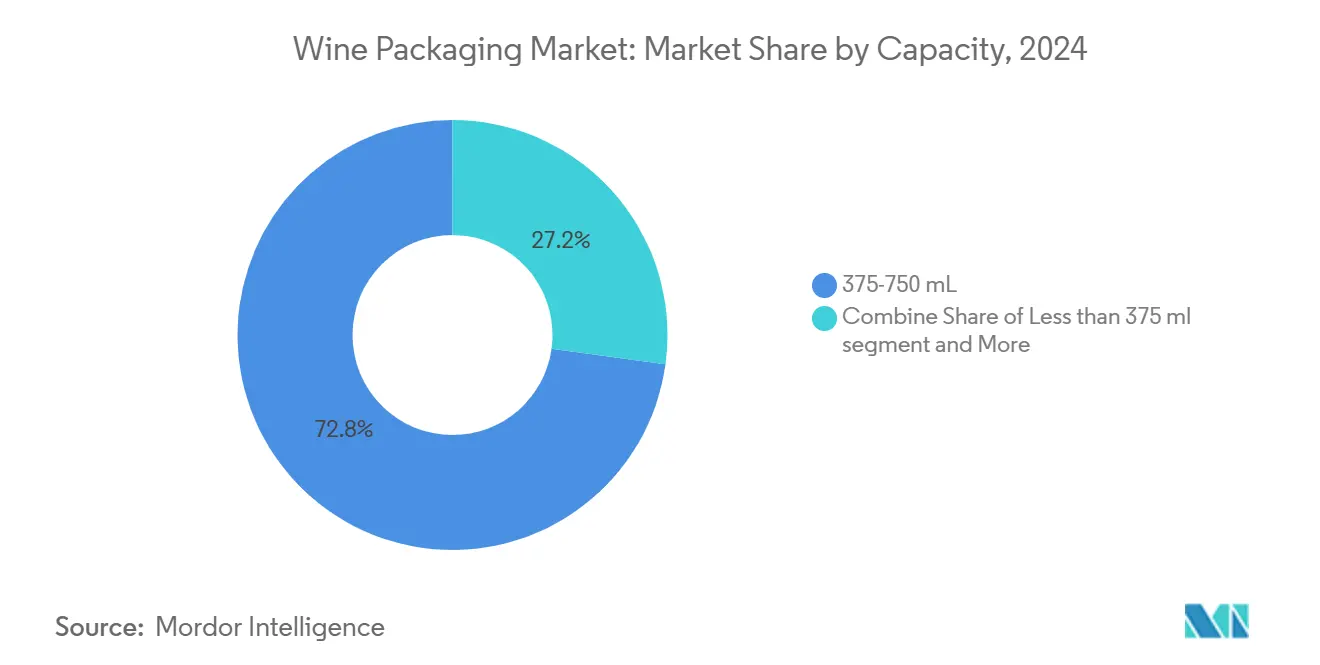
Note: Segment shares of all individual segments available upon report purchase
By Distribution Channel: Direct Sales Lead with Indirect Growth
Direct channels held a 70.28% share in 2024, underpinned by winery clubs and destination tourism that favor custom shipping units in the wine packaging market. Retail and e-commerce platforms fuel indirect growth at 2.14% CAGR, demanding pallet-friendly cases and tamper-proof seals.
Hybrid strategies emerge as wineries meld personalized DtC experiences with broad grocery reach. Packaging capable of automated fulfilment yet delivering a premium unboxing becomes decisive, reflecting omnichannel complexity across the wine packaging industry.
Geography Analysis
Europe and North America remain the largest revenue contributors. Robust DtC laws and recycling expansion in California integrate 5- and 10-cent deposits that steer the wine packaging market toward curbside-compatible designs. European policies dictate 100% recyclability by 2030, sparking investment in electric furnaces and bag-in-box innovation that lowers freight emissions.
Asia-Pacific leads growth through 2030. China’s premiumisation mixes designer glass with cost-effective boxes, while Australia grants back lightweight PET and paper bottles, accelerating regional momentum for the wine packaging market. E-grocery convenience intertwines with environmental marketing to convert younger consumers.
The Middle East and Africa, and South America, provide emerging pathways. Warmer climates lean toward lighter, oxidation-barrier formats, and exporters deploy packaging that meets EU rules while minimizing freight. Domestic producers explore rPET and canning lines to reach new drinkers, illustrating the global spread of the wine packaging industry’s innovations.
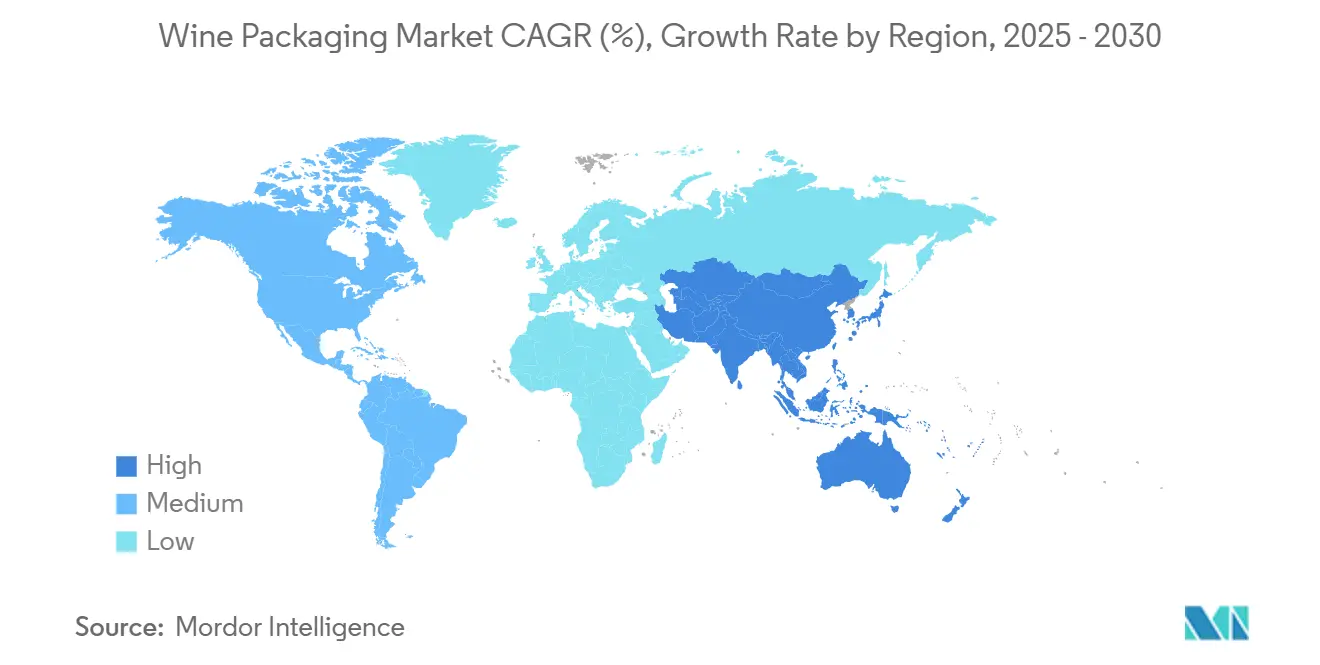
Competitive Landscape
Market concentration is fragmented. Owens-Illinois, Verallia, and Ardagh Group dominate glass, yet face aluminum stalwarts such as Ball and disruptive paper pioneers like Frugalpac. Verallia’s 300 g Bordeaux Air bottle reduces emissions 40%, reinforcing incumbency while meeting the wine packaging market’s low-carbon targets.
Start-ups leverage agility: Packamama’s flat PET bottle secures government funding in Australia, and Frugalpac’s US rollout with Target places 256,000 units on shelf, broadening consumer access. TricorBraun’s acquisitions of Euroglas and Glaspack highlight consolidation as distributors seek scale across the wine packaging market.
Technology patents on multilayer pouches, self-aerating bottles and IoT-enabled trackers proliferate, creating new points of differentiation. Partnerships between closure specialists and analytics firms track oxygen ingress in real time, enhancing quality control inside the wine packaging industry.
Wine Packaging Industry Leaders
-
Owens-Illinois Inc. (O-I)
-
Verallia SA
-
Ardagh Group SA
-
Saverglass SAS
-
SIG Combibloc Group AG
- *Disclaimer: Major Players sorted in no particular order
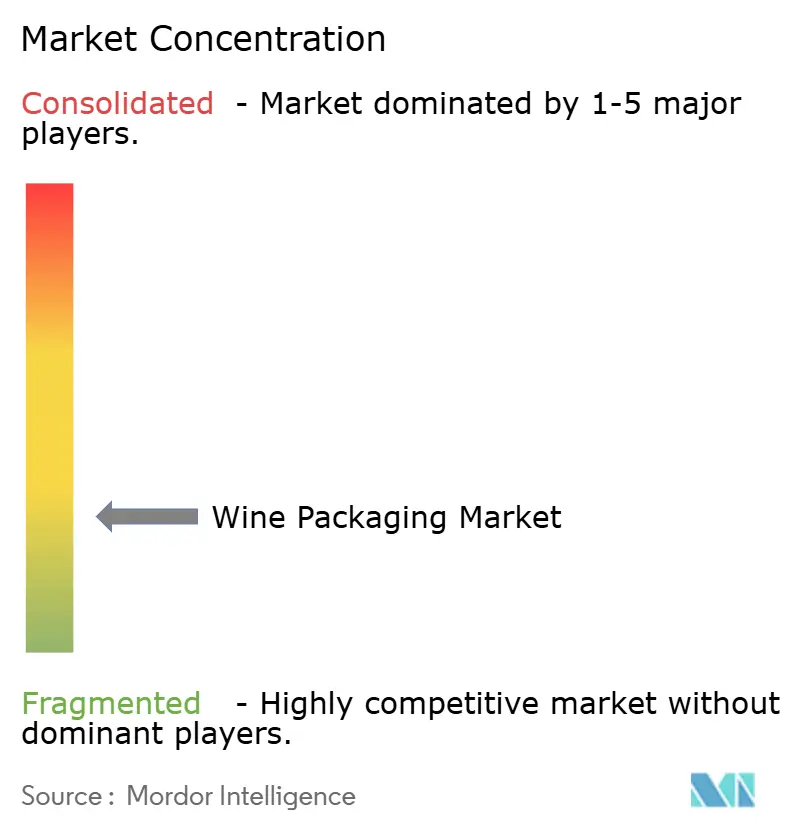
Recent Industry Developments
- May 2025: Ball reported 2.6% shipment growth and reaffirmed double-digit EPS guidance, underlining aluminum’s momentum in the wine packaging market.
- May 2025: Smurfit Westrock posted USD 7,656 million Q1 sales and added converting plants while closing 500,000 tons of paper capacity to streamline operations.
- April 2025: FitVine introduced resealable aluminum bottles for active consumers, extending premium positioning beyond glass.
- February 2025: ProMach launched a Wine & Spirits Solutions Group to integrate packaging lines for DtC efficiency
Global Wine Packaging Market Report Scope
The process of providing a protective and informative covering to the product so that it helps to protect the product during its handling, storage, and movement is termed packaging. It provides valuable information about the content of the package.
The study tracks the demand for the packaging market through the revenue derived from glass, plastic, metal, and paperboard. It also includes the effect of regulations and drivers on market growth. The Wine Packaging Market is segmented by Packaging Material (Glass, Plastic, Metal, Paper), Product Type (Glass Bottles, Plastic Bottles, Bag in Box, Cans, Pouches, and Boxes and Other Products), and Geography. The market sizes and projections are provided in USD million for all the mentioned segments.
| Glass |
| Plastic |
| Metal |
| Paper |
| Glass Bottles |
| Plastic Bottles |
| Bag-in-Box |
| Cans |
| Pouches |
| Boxes and Other Products |
| Natural Cork |
| Technical/Synthetic Cork |
| Screw Caps |
| Crown Caps |
| Others (T-stoppers, Vino-Lok) |
| Still Wine |
| Sparkling Wine |
| Fortified and Dessert Wine |
| Low and No-Alcohol Wine |
| Less than 375 mL |
| 375-750 mL |
| 751-1,500 mL |
| More than 1,500 mL |
| Direct Sales |
| Indirect Sales |
| North America | United States | |
| Canada | ||
| Mexico | ||
| Europe | Germany | |
| United Kingdom | ||
| France | ||
| Italy | ||
| Spain | ||
| Russia | ||
| Rest of Europe | ||
| Asia-Pacific | China | |
| India | ||
| Japan | ||
| South Korea | ||
| Australia and New Zealand | ||
| Rest of Asia-Pacific | ||
| Middle East and Africa | Middle East | United Arab Emirates |
| Saudi Arabia | ||
| Turkey | ||
| Rest of Middle East | ||
| Africa | South Africa | |
| Nigeria | ||
| Egypt | ||
| Rest of Africa | ||
| South America | Brazil | |
| Argentina | ||
| Rest of South America | ||
| By Material Type | Glass | ||
| Plastic | |||
| Metal | |||
| Paper | |||
| By Product Type | Glass Bottles | ||
| Plastic Bottles | |||
| Bag-in-Box | |||
| Cans | |||
| Pouches | |||
| Boxes and Other Products | |||
| By Closure Type | Natural Cork | ||
| Technical/Synthetic Cork | |||
| Screw Caps | |||
| Crown Caps | |||
| Others (T-stoppers, Vino-Lok) | |||
| By Wine Type | Still Wine | ||
| Sparkling Wine | |||
| Fortified and Dessert Wine | |||
| Low and No-Alcohol Wine | |||
| By Capacity | Less than 375 mL | ||
| 375-750 mL | |||
| 751-1,500 mL | |||
| More than 1,500 mL | |||
| By Distribution Channel | Direct Sales | ||
| Indirect Sales | |||
| By Geography | North America | United States | |
| Canada | |||
| Mexico | |||
| Europe | Germany | ||
| United Kingdom | |||
| France | |||
| Italy | |||
| Spain | |||
| Russia | |||
| Rest of Europe | |||
| Asia-Pacific | China | ||
| India | |||
| Japan | |||
| South Korea | |||
| Australia and New Zealand | |||
| Rest of Asia-Pacific | |||
| Middle East and Africa | Middle East | United Arab Emirates | |
| Saudi Arabia | |||
| Turkey | |||
| Rest of Middle East | |||
| Africa | South Africa | ||
| Nigeria | |||
| Egypt | |||
| Rest of Africa | |||
| South America | Brazil | ||
| Argentina | |||
| Rest of South America | |||
Key Questions Answered in the Report
What is the current size of the wine packaging market?
The wine packaging market size was USD 6.85 billion in 2025 and is forecast to reach USD 7.92 billion by 2030.
Which material dominates global wine packaging?
Glass leads with 68.71% share, thanks to its proven preservation abilities and premium image.
Why are lightweight glass bottles gaining popularity?
They reduce CO₂ emissions by up to 40% while retaining brand aesthetics, aligning with strict EU sustainability rules.
Which packaging format is growing fastest?
Bag-in-box segment is expanding at a 6.14% CAGR, driven by portability and younger consumer appeal.
How are EU regulations shaping packaging choices?
The Packaging and Packaging Waste Regulation requires 100% recyclable solutions by 2030, pushing suppliers toward lighter, recyclable and recycled-content materials.
What role does direct-to-consumer shipping play in packaging design?
DtC growth prioritizes protective, recyclable and brand-focused shipping formats that perform both in transit and at unboxing.
Page last updated on:
